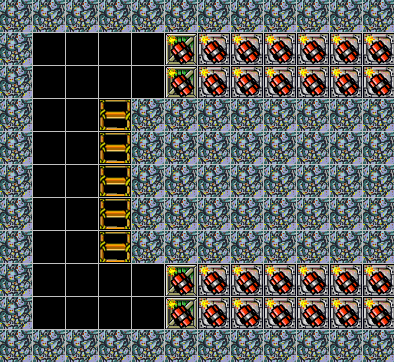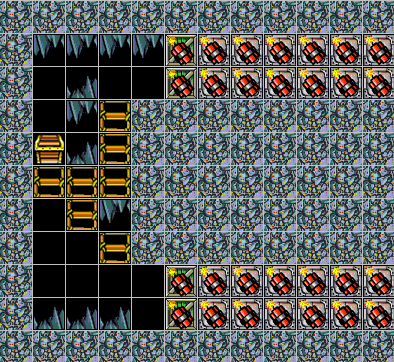
|
|
| Connecting Traps Wednesday, May 13, 2009 10:02 pm — Guide posted by jebby |
« jebby's Blog
Connecting Traps: Why and How
Before I start, let me just explain that this section is not about special traps called ‘connecting traps’. It is simply about how to connect one trap to another and how to make a cave flow.
A cave, as we know, is not about one big trap. It is a series of traps – all of which are designed to trip you up in some way or another. A cave needs some way of linking these traps up that makes it attractive to play. It isn’t just a case of finishing one trap and starting another. Okay, sometimes it is, but there are ways you can do it to give the cave style.
Some trap connections are purely for show and are a bit useless when it comes to affecting gameplay. Other connections are complicated and involve one trap directly influencing the other.
How do you do this? Like trap-making, the way traps are connected is usually unique to the person who makes them. There are several common ‘base connections’ that you’ll see in a lot of caves. It is here that I am going to point them out to you.
Placing Time Limits
Let’s take the unknowing cavemaker and ask them to make a cave with two traps. They might make this:

This isn’t necessarily bad, but each trap is very separate from the other. These are both floating traps. The only connection we have at the moment is the fact that you have to jump from one to the other and you can spend as much as you like doing that as long as you get the first treasure chest. Already we have two starting points:
1. You jump from one trap to the other.
2. You have to complete one trap before the other.
How can we add to this? First, we can join the two traps up visually. The first platform will be extended and a ladder will connect the two traps. Secondly, there can be a more interesting connection that forces an action from the player. If we skip the first trap (which is impossible in this particular situation) and then tackle the second trap, we won’t be able to beat the cave because it’s too high to jump back up to the first again. We have to beat the first trap to finish the cave. As I pointed out above, you are only limited in time within the actual trap (get the treasure chest before steel crates block it) – you can spend as time as you like going from to another. Therefore, a time limit can be placed between the two traps:

The player no longer has the luxury of having all the time in the world to finish the first trap, has a more restricted route from one trap to the other and you have to get to the first trap in a shorter time limit. As this is such a small example, it could be said that the two traps have been connected to become one. Placing time limits on a larger scale with more space between the traps makes it obvious that you’ve got two traps with a connection rather than one.
Fillers
On many occasions, you may not want to connect traps with arrows where you have to get somewhere in a certain time. In caves where there is a lot of terrain and spikes, you may want to have a simple passageway in between with no time limits. The only limit in these connections is movement. Here is a pair of traps with a pretty boring connection (note that the blocks of dynamite aren’t really traps and are just used for the example):

You finish one trap, climb up the ladder and start the other. If simplicity or enjoyment is the theme in your cave then this may be a nice connector that is very playable. If you are making something of rather more complex design, you may choose this one:

This is more sinister than the simple ladder from bottom to top. It breaks up the rhythm of play and fills up useless gaps. If you’re a really good cavemaker, you might even be able to make better…
From One Trap Straight Into Another
We’re moving into the realms of continuous motion caving here – a cave with constant movement and an infinite need for concentration. The idea of this kind of connection is that as soon as you reach the objective of one trap, you bump into the incentive of the next trap. Let’s add this to the above example:

As soon as you finish the bottom trap, you walk into the arrow that sets off a chain of events. You have to get the treasure chest before it gets blocked off and through the top opening before the steel crates drop down. As soon as you go through the opening, you set off the next trap. This is the ideal form of trap connection though it is sometime pretty hard to put together. The second picture on this page depicts a similar trap connection.
Before we move on to discussing layout ideas, I’ll say that caves aren’t all about making the best traps possible. The best caves are the ones that make you think, give you many different options to choose from and confuse you from the start. Some examples of these types of caves will be analysed later in the manual.
| There are no comments yet, so feel free to be the first to comment. | ||
« Forum Index < The Hannah and the Pirate Caves Board
In order to post in the forums, you must be logged into your account.
Click here to login.
All games copyrighted to their respective owners.



 ShareThis
ShareThis